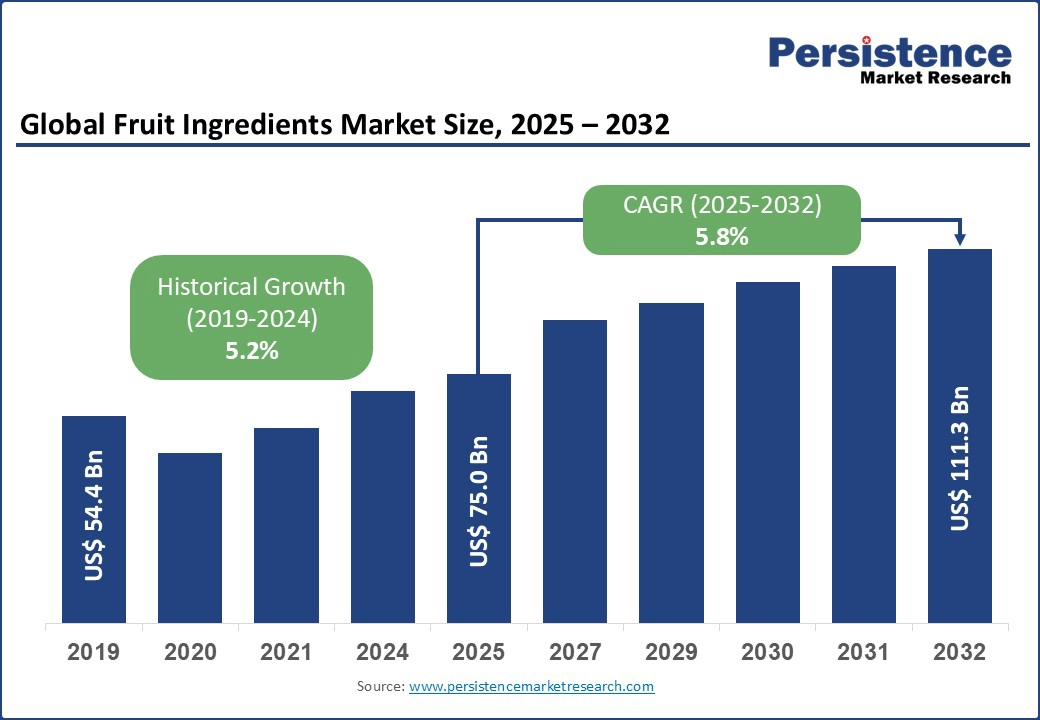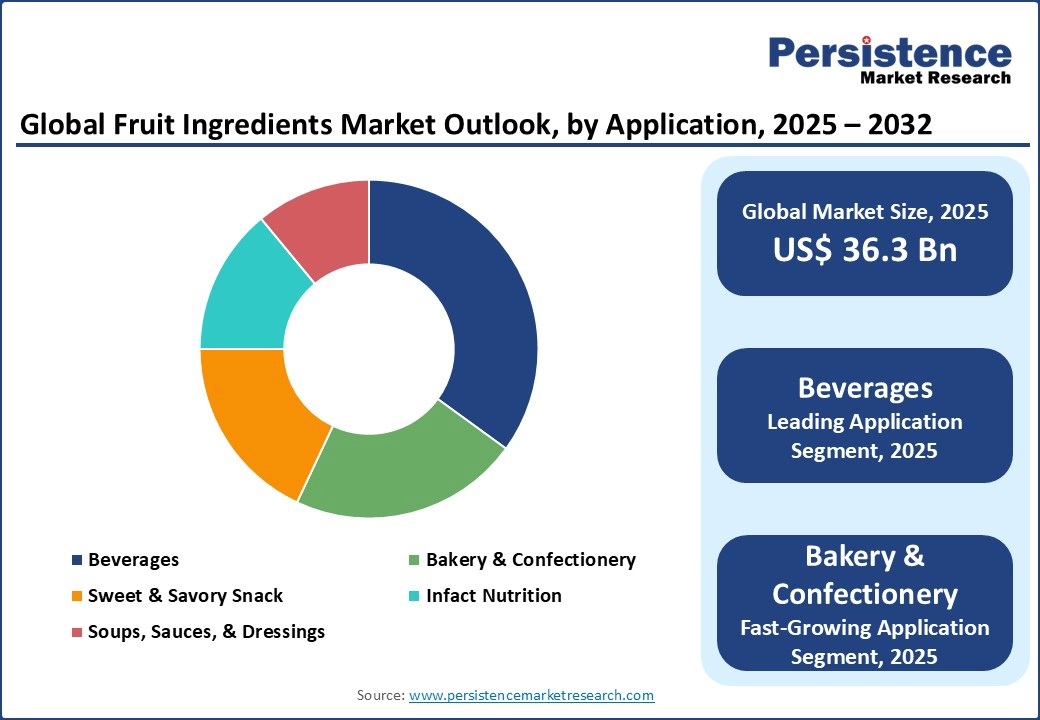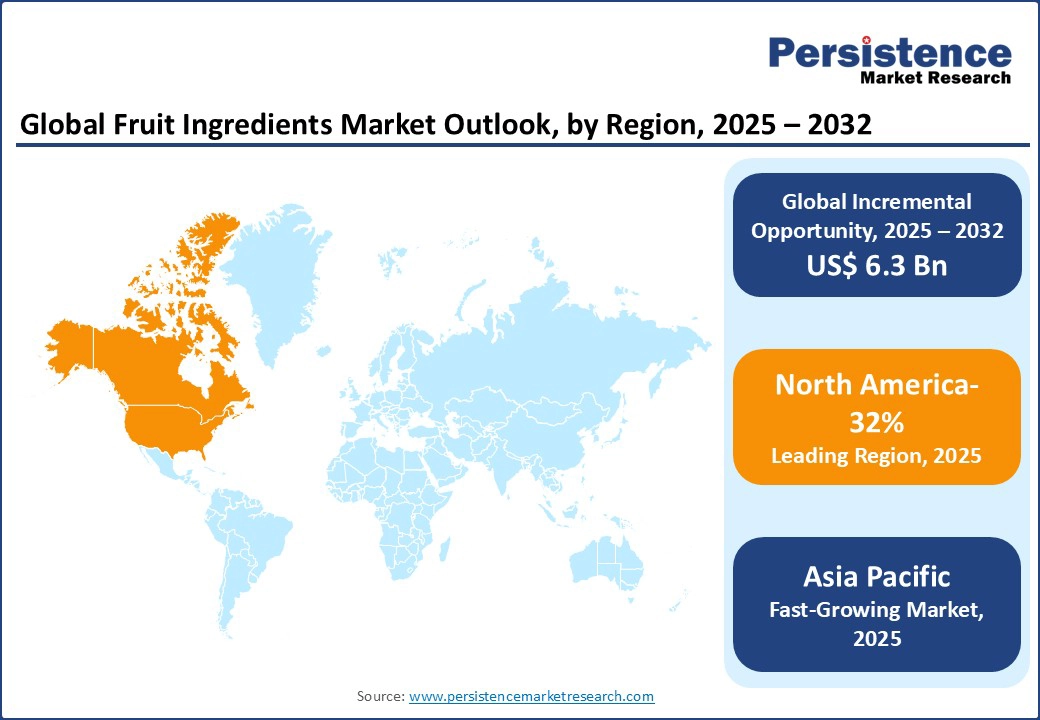ID: PMRREP28003| 187 Pages | 28 Aug 2025 | Format: PDF, Excel, PPT* | Food and Beverages

The global fruit ingredients market size is likely to be valued at US$ 75.0 Bn in 2025 and is expected to reach US$ 111.3 Bn by 2032, growing at a CAGR of 5.8% during the forecast period from 2025 to 2032.
The Fruit Ingredients Market is driven by rising consumer demand for natural, healthy, and clean-label food products, advancements in food processing technologies, and the growing popularity of plant-based and functional foods.
Fruit juice ingredients, including concentrates, purees & pastes, NFC juices, and pieces & powder, are pivotal for enhancing flavor, nutrition, and texture in various food and beverage applications, supporting the industry's shift toward sustainable and health-focused solutions.
Key Industry Highlights

|
Global Market Attribute |
Key Insights |
|
Fruit Ingredients Market Size (2019) |
US$ 54.4 Bn |
|
Fruit Ingredients Market Size (2025E) |
US$ 75.0 Bn |
|
Market Value Forecast (2032F) |
US$ 111.3 Bn |
|
Projected Growth (CAGR 2025-2032) |
5.8% |
|
Historical Market Growth (CAGR 2019-2024) |
5.2% |
The rising global focus on health and wellness is a major driver of the Fruit Ingredients Market. As consumers increasingly shift toward clean-label, natural, and nutrient-rich products, fruit-based ingredients such as purees, concentrates, powders, and NFC juices are witnessing higher demand across food and beverage sectors.
These ingredients are packed with vitamins, antioxidants, and fibers, aligning with growing preferences for functional and immunity-boosting foods. This trend is particularly prominent in product categories such as smoothies, dairy alternatives, energy bars, and fortified snacks, which heavily rely on Fruit juice ingredients to meet consumer expectations for both taste and nutrition.
For instance, the launch of no-added-sugar fruit puree blends and probiotic-enriched fruit snacks has surged in markets such as North America and Europe. Brands are leveraging the health halo of fruits to market their products as guilt-free and naturally healthy, directly contributing to the market growth. The wellness trend continues to shape product innovation globally.
Challenges such as material price volatility and seasonal supply constraints deter demand. Fruit prices fluctuated by 15% in 2025 due to climate change impacts and supply chain disruptions, increasing production costs for concentrates and purees. This affects profitability, particularly for small-scale manufacturers in price-sensitive regions.
Competition from synthetic flavors and preservatives limits growth, with 30% of producers opting for cheaper alternatives in bakery applications. Regulatory restrictions on food additives have raised compliance costs by 10%, impacting smaller operations. The limited shelf life of NFC juices, prone to spoilage, results in waste rates of 12%, constraining adoption in distant markets. Supply chain disruptions, driven by geopolitical tensions, have caused 10% shortages in tropical fruits, affecting pieces & powder availability.
The rise of plant-based and functional food products presents significant opportunities. The global plant-based food market, drives demand for natural fruit juice ingredients such as purees in vegan alternatives. A study reports that 25% of new product launches feature fruit-based innovations, positively boosting sweet & savory snack applications.
E-commerce channels for food ingredients, growing at 15% in 2025. E-commerce channels enhance accessibility for NFC juices and powders. Companies are investing US$ 10 Bn in R&D for functional Fruit juice ingredients, targeting infant nutrition in emerging markets with 2 Bn young consumers by 2030. Advances in sustainable processing, such as cold-pressing for NFC juices, and clean-label formulations offer differentiation, positioning Fruit juice ingredients as key drivers in beverages and bakery applications.
The purees and pastes represent the dominant form type, accounting for approximately 40% of the share. Their widespread use across various applications such as baby food, bakery fillings, yogurt, smoothies, and confectionery products stems from their rich texture, natural flavor, and nutritional profile.
Fruit purees are especially favored in processed food manufacturing due to their ease of blending and ability to retain fruit authenticity without the need for artificial additives. The strong demand for convenient, ready-to-use, and clean-label food solutions continues to drive the dominance of purees and pastes.
On the other hand, NFC juices are emerging as the fastest-growing form type. Consumers increasingly prefer minimally processed, natural juice options that retain the original flavor and nutritional value of the fruit. NFC juices are gaining traction in premium beverages and health-oriented product lines, particularly in North America and Europe.
With the global shift toward wellness and transparency in food labeling, the NFC segment is projected to grow rapidly in the coming years, supported by innovations in cold-press and clean-label juice technologies.
The beverages hold the position as the dominant application, accounting for approximately 35% share in 2025. The demand for natural fruit-based beverages, such as juices, smoothies, flavored waters, and energy drinks, has surged due to growing health consciousness and consumer preference for clean-label, functional drinks.
Fruit juice ingredients such as NFC juices, concentrates, and fruit powders are extensively used in beverage formulations to enhance flavor, color, and nutritional content. The beverage sector's innovation in low-sugar and fortified drinks further strengthens Fruit juice ingredients’ role in this segment.
Bakery and confectionery is the fastest-growing application segment in the Fruit Ingredients Market. Rising consumer interest in natural flavorings and clean-label bakery products is driving demand for fruit purees, pastes, and dried pieces. These ingredients are increasingly incorporated into cakes, pastries, chocolate fillings, cereal bars, and gummy candies. The growth is particularly strong in Europe and Asia Pacific, where premium and health-focused baked goods are gaining popularity

North America dominates the global market, capturing nearly 32% of the total share in 2025. The region’s growth is driven by strong demand for clean-label and health-focused food products. Consumers increasingly prefer natural Fruit juice ingredients in beverages, bakery, and dairy applications.
A well-established food processing sector, innovation in product formulation, and rising awareness of nutritional benefits further support market expansion. The U.S. leads the region with advanced R&D and wide adoption of fruit-based ingredients across functional foods and fortified drinks, making North America a key driver of growth in the Fruit juice ingredients industry.
Europe holds a notable share in the Fruit Ingredients Market, backed by strong consumer demand for organic, sustainable, and health-driven products. Countries such as Germany, France, and the UK lead in the use of Fruit juice ingredients across confectionery, yogurt, baked goods, and beverages.
Stringent food safety regulations and increasing interest in clean-label ingredients continue to drive innovation in the region. European manufacturers are also investing in eco-friendly sourcing and production, aligning with consumer values. The market’s maturity and consistent focus on quality make Europe a major player in shaping trends within the global scenario.
Asia Pacific is witnessing the fastest growth in the Fruit Ingredients Market, fueled by urbanization, rising disposable incomes, and growing health awareness. Countries such as China, India, and Japan are experiencing increased consumption of fruit-based products, especially in the beverage, bakery, and snack sectors.
The expanding food processing industry and demand for natural ingredients are accelerating the adoption of purees, powders, and concentrates. Additionally, government support for nutrition-focused food production enhances growth prospects. With a strong shift toward wellness and functional foods, Asia Pacific is emerging as a dynamic hub for future expansion.

The global Fruit Ingredients Market competitive landscape is characterized by innovation, product diversification, and a strong focus on clean-label solutions. Companies are investing in R&D to develop natural, organic, and functional fruit-based ingredients that cater to evolving consumer preferences.
Advanced processing technologies, such as freeze-drying and cold pressing, are widely adopted to retain flavor and nutrition. The market also shows increasing regional expansion, with Asia Pacific players gaining momentum.
The fruit ingredients market is projected to reach US$ 75.0 Bn in 2025, driven by demand for natural ingredients in beverages.
Key drivers include health-conscious consumer trends, plant-based diets, and urbanization.
The fruit ingredients market is expected to grow at a CAGR of 5.8% from 2025 to 2032, reaching US$ 111.3 Bn.
Opportunities include plant-based product expansion, e-commerce growth, and functional food innovations.
Leading players include ADM, Olam International, Cargill Incorporated, Kerry Group, and Döhler Group.
|
Report Attribute |
Details |
|
Historical Data/Actuals |
2019 - 2024 |
|
Forecast Period |
2025 - 2032 |
|
Market Analysis Units |
Value: US$ Bn |
|
Geographical Coverage |
|
|
Segmental Coverage |
|
|
Competitive Analysis |
|
|
Report Highlights |
|
|
Customization and Pricing |
Available upon request |
By Form Type
By Application
By Region
Delivery Timelines
For more information on this report and its delivery timelines please get in touch with our sales team.
About Author